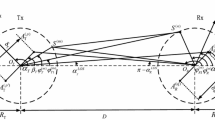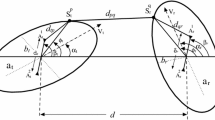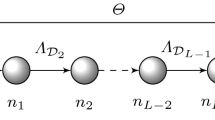Abstract
This paper deals with the modeling and analysis of narrowband mobile-to-mobile (M2M) fading channels for amplify-and-forward relay links under line-of-sight (LOS) conditions. It is assumed that a LOS component exists in the direct link between the source mobile station (SMS) and the destination mobile station (DMS), as well as in the links via the mobile relay (MR). The proposed channel model is referred to as the multiple-LOS second-order scattering (MLSS) channel model. The MLSS channel model is derived from a second-order scattering process, where the received signal is modeled in the complex baseband as the sum of a single and a double scattered component. Analytical expressions are derived for the mean value, variance, probability density function (PDF), cumulative distribution function (CDF), level-crossing rate (LCR), and average duration of fades (ADF) of the received envelope of MLSS channels. The PDF of the channel phase is also investigated. It is observed that the LOS components and the relay gain have a significant influence on the statistics of MLSS channels. It is also shown that MLSS channels include various other channel models as special cases, e.g., double Rayleigh channels, double Rice channels, single-LOS double-scattering (SLDS) channels, non-line-of-sight (NLOS) second-order scattering (NLSS) channels, and single-LOS second-order scattering (SLSS) channels. The correctness of all analytical results is confirmed by simulations using a high performance channel simulator. Our novel MLSS channel model is of significant importance for the system level performance evaluation of M2M communication systems in different M2M propagation scenarios. Furthermore, our studies pertaining to the fading behavior of MLSS channels are useful for the design and development of relay-based cooperative wireless networks.






Similar content being viewed by others
Notes
The PSD \(S_{\mu^{\left(i\right)}\mu^{\left(i\right)}}\left(f\right)\) is an even function. Then, \(\mu^{\left(i\right)}\left(t\right)\) and \(\dot{\mu}^{\left(i\right)}\left(t\right)\) are uncorrelated at the same point in time, because \(r_{\mu^{\left(i\right)}\dot{\mu}^{\left(i\right)}}\left(0\right) =-\frac{d}{d\tau}r_{\mu^{\left(i\right)}\mu^{\left(i\right)}}\left(\tau\right)|_{0} =-j2\pi\int\limits^{\infty}_{-\infty}f\,S_{\mu^{\left(i\right)}\mu^{\left(i\right)}}\left(f\right)\,d\tau=0\). Since, \(\mu^{\left(i\right)}\left(t\right)\) and \(\dot{\mu}^{\left(i\right)}\left(t\right)\) are uncorrelated Gaussian processes, it follows that \(\mu^{\left(i\right)}\left(t\right)\) and \(\dot{\mu}^{\left(i\right)}\left(t\right)\) are also independent [28].
References
Akki AS, Haber F (1986) A statistical model of mobile-to-mobile land communication channel. IEEE Trans Veh Technol 35(1):2–7
Dohler M (2003) Virtual antenna arrays. PhD dissertation, King’s College, London
Barbarossa S, Scutari G (2003) Cooperative diversity through virtual arrays in multihop networks. In: Proc. IEEE international conf. acoustics, speech, signal processing, vol 4. Hong Kong, China, pp 209–212
Sendonaris A, Erkip E, Aazhang B (2003) User cooperation diversity—Part I: system description. IEEE Trans Commun 51(11):1927–1938
Sendonaris A, Erkip E, Aazhang B (2003) User cooperation diversity—Part II: implementation aspects and performance analysis. IEEE Trans Commun 51(11):1939–1948
Laneman JN, Tse DNC, Wornell GW (2004) Cooperative diversity in wireless networks: efficient protocols and outage behavior. IEEE Trans Inf Theory 50(12):3062–3080
Andersen JB (2002) Statistical distributions in mobile communications using multiple scattering. In: Proc 27th URSI general assembly. Maastricht, Netherlands
Ercerg V, Fortune SJ, Ling J, Rustako AJ Jr, Valenzuela RA (1997) Comparison of a computer-based propagation prediction tool with experimental data collected in urban microcelluar environment. IEEE J Sel Areas Commun 15(4):677–684
Kovacs IZ, Eggers PCF, Olesen K, Petersen LG (2002) Investigations of outdoor-to-indoor mobile-to-mobile radio communication channels. In: Proc. IEEE 56th veh. technol. conf., VTC’02-Fall, vol 1. Vancouver BC, Canada, pp 430–434
Akki AS (1994) Statistical properties of mobile-to-mobile land communication channels. IEEE Trans Veh Technol 43(4):826–831
Maurer J, Fügen T, Wiesbeck W (2002) Narrow-band measurement and analysis of the inter-vehicle transmission channel at 5.2 GHz. In: Proc. IEEE 55th semiannual veh. technol. conf., VTC’02-Spring, vol 3. Birmingham, Alabama, pp 1274–1278
Pätzold M, Hogstad BO, Youssef N (2008) Modeling, analysis, and simulation of MIMO mobile-to-mobile fading channels. IEEE Trans Wirel Commun 7(2):510–520
Zajić AG, Stüber GL (2008) Space-time correlated mobile-to-mobile channels: modelling and simulation. IEEE Trans Veh Technol 57(2), 715–726
Patel CS, Stüber GL, Pratt TG (2006) Statistical properties of amplify and forward relay fading channels. IEEE Trans Veh Technol 55(1):1–9
Salo J, El-Sallabi HM, Vainikainen P (2006) Impact of double-Rayleigh fading on system performance. In: Proc. 1st IEEE int. symp. on wireless pervasive computing, ISWPC 2006. Phuket, Thailand. doi:0-7803-9410-0/10.1109/ISWPC.2006.1613574
Almers P, Tufvesson F, Molisch AF (2006) Keyhole effect in MIMO wireless channels: measurements and theory. IEEE Trans Wirel Commun 5(12):3596–3604
Shin H, Lee JH (2004) Performance analysis of space-time block codes over keyhole Nakagami-m fading channels. IEEE Trans Veh Technol 53(2):351–362
Sagias NC, Tombras GS (2007) On the cascaded Weibull fading channel model. J Franklin Inst 344:1–11 (Elsevier Ltd)
Talha B, Pätzold M (2007) On the statistical properties of double Rice channels. In: Proc. 10th international symposium on wireless personal multimedia communications, WPMC 2007. Jaipur, India, pp 517–522
Salo J, Salmi J, Vainikainen P (2005) Distribution of the amplitude of a sum of singly and doubly scattered fading radio signal. In: Proc. IEEE 61st semiannual veh. tech. conf., VTC’05-Spring, vol 1. Stockholm, Sweden, pp 87–91
Salo J, El-Sallabi HM, Vainikainen P (2006) Statistical analysis of the multiple scattering radio channel. IEEE Trans Antennas Propag 54(11):3114–3124
Talha B, Pätzold M (2007) On the statistical properties of mobile-to-mobile fading channels in cooperative networks under line-of-sight conditions. In: Proc. 10th international symposium on wireless personal multimedia communications, WPMC 2007. Jaipur, India, pp 388–393
Talha B, Pätzold M (2008) A novel amplify-and-forward relay channel model for mobile-to-mobile fading channels under line-of-sight conditions. In: Proc. 19th IEEE int. symp. on personal, indoor and mobile radio communications, PIMRC 2008. Cannes, France, pp 1–6. doi:10.1109/PIMRC.2008.4699733
Nabar RU, Bölcskei H, Kneubühler FW (2004) Fading relay channels: performance limits and space-time signal design. IEEE J Sel Areas Commun 22(6):1099–1109
Azarian K, Gamal HE, Schniter P (2005) On the achievable diversity-multiplexing tradeoff in half-duplex cooperative channels. IEEE Trans Inf Theory 51(12):4152–4172
Nabar RU, Bölcskei H (2003) Space-time signal design for fading relay channels In: Proc. IEEE globecom, vol 4. San Francisco, pp 1952–1956
Jakes WC (ed) (1994) Microwave mobile communications. IEEE, Piscataway
Papoulis A, Pillai SU (2002) Probability, random variables and stochastic processes, 4th edn. McGraw-Hill, New York
Simon MK (2002) Probability distributions involving gaussian random variables: a handbook for engineers and scientists. Kluwer Academic, Dordrecht
Pätzold M (2002) Mobile fading channels. Wiley, Chichester
Gradshteyn IS, Ryzhik IM (2000) Table of integrals, series, and products, 6th edn. Academic, New York
Rice SO (1945) Mathematical analysis of random noise. Bell Syst Tech J 24:46–156
Proakis J, Salehi M (2008) Digital communications, 5th edn. McGraw-Hill, New York
Tsie KY, Fines P, Aghvami AH (1992) Concatenated code and interleaver design for data transmission over fading channels. In: Proc. 9th international conference on digital satellite communications, ICDSC-9. Copenhagen, Denmark, pp 253–259
Biglieri E, Divsalar D, McLane PJ, Simon MK (1991) Introduction to trellis-coded modulation with applications. Macmillan, New York
Morris JM (1992) Burst error statistics of simulated Viterbi decoded BPSK on fading and scintillating channels. IEEE Trans Commun 40(1):34–41
Rice SO (1944) Mathematical analysis of random noise. Bell Syst Tech J 23:282–332
Patel CS, Stüber GL, Pratt TG (2005) Comparative analysis of statistical models for the simulation of Rayleigh faded cellular channels. IEEE Trans Commun 53(6):1017–1026
Höher P (1992) A statistical discrete-time model for the WSSUS multipath channel. IEEE Trans Veh Technol 41(4):461–468
Yip K-W, Ng T-S (1995) Efficient simulation of digital transmission over WSSUS channels. IEEE Trans Commun 43(12):2907–2913
Han J-K, Yook J-G, Park H-K (2002) A deterministic channel simulation model for spatially correlated Rayleigh fading. IEEE Commun Lett 6(2):58–60
Pätzold M, Youssef N (2001) Modelling and simulation of direction-selective and frequency-selective mobile radio channels. Int J Electron Commun AEÜ-55(6):433–442
Pätzold M, Hogstad BO (2004) A space-time channel simulator for MIMO channels based on the geometrical one-ring scattering model. Wirel Commun Mob Comput 4(7):727–737 (Special Issue on Multiple-Input Multiple-Output (MIMO) Communications)
Pätzold M, Killat U, Laue F (1996) A deterministic digital simulation model for Suzuki processes with application to a shadowed Rayleigh land mobile radio channel. IEEE Trans Veh Technol 45(2):318–331
Pätzold M, Killat U, Laue F, Li Y (1998) On the statistical properties of deterministic simulation models for mobile fading channels. IEEE Trans Veh Technol 47(1):254–269
Zheng YR, Xiao C (2002) Improved models for the generation of multiple uncorrelated Rayleigh fading waveforms IEEE Commun Lett 6(6):256–258
Pätzold M, Hogstad BO, Kim D (2007) A new design concept for high-performance fading channel simulators using set partitioning. Wirel Pers Commun 40(2):267–279
Pätzold M, Hogstad BO (2006) Two new methods for the generation of multiple uncorrelated Rayleigh fading waveforms. In: Proc. IEEE 63rd semiannual veh. tech. conf., VTC’06-Spring, vol 6. Melbourne, Australia, pp 2782–2786
Watson GN (1995) A treatise on the theory of Bessel functions, 2nd edn. Cambridge University Press, Bentley House, London
Oppenheim AV, Willsky AS, Hamid S (1996) Signals & systems, 2nd edn. Prentice-Hall, Inc., New Jersey
Papoulis A (1977) Signal analysis, 3rd edn. McGraw-Hill, Auckland
Author information
Authors and Affiliations
Corresponding author
Additional information
The material in this paper was presented in part at the 19th IEEE International Symposium on Personal, Indoor and Mobile Radio Communications, PIMRC 2008, Cannes, France, September 2008.
The material in this paper has been published in part in the proceedings of the 51st IEEE Globecom 2008, New Orleans, USA, December 2008.
Appendices
Appendix A: Proof of (30)
For ρ 1 = 0, \(A_{\mbox{\tiny MR}}=1\), and \(\sigma^2_1\rightarrow0\), (15) reduces to
for x ≥ 0. Furthermore, using the asymptotic expansions of the zeroth-order modified Bessel function of the first kind \(I_{0}\left(\cdot\right)\) [49, Sec. (7.23), Eq. (2)], allows us to write X 1 as
Substituting (55) in (54) gives
for x ≥ 0. Applying the sifting property of the delta function [50] on (56) gives
Numerical investigations show that it is possible to approximate X 2 in (57) as
Thus, replacing (58) in (57) gives (30).
Appendix B: Proof of (35)
Substituting ρ 1 = ρ 2 = ρ 3 = 0 and \(A_{\mbox{\tiny MR}}=1\) in (15), we can express \(p_{\Xi}\left(x\right)\left|_{\begin{subarray}{l} \rho1,\rho_2,\rho_3=0\\ A_{\mbox{\tiny MR}}=1 \end{subarray}}\right.\) as follows
where X 3 is obtained by using [31, Eq. (3.478.4)]. Taking the limit \(\sigma^2_1\rightarrow0\), (59) can be written as
Using the asymptotic expansions of the zeroth-order modified Bessel function of the first kind \(I_{0}\left(\cdot\right)\) [49, Sec. (7.23), Eq. (2)], (60) can be expressed as
where \(X_5=\delta\left(\omega-x\right)\) by definition of the delta function [51]. Thus, (61) can be written as
Applying the sifting property of the delta function [50] on (62), results in (35).
Appendix C: Proof of (40)
Substituting ρ 2 = ρ 3 = 0 as well as \(A_{\mbox{\tiny MR}}=1\) and integrating (12) over θ from − π to π allows us to write \(p_{\Xi}\left(x\right)\left|_{\begin{subarray}{l} \rho_2,\rho_3=0\\ A_{\mbox{\tiny MR}}=1 \end{subarray}}\right.\) as
for x ≥ 0. In (63), X 6 is evaluated using [31, Eq. (3.478.4)], whereas X 7 with the help of [31, Eq. (3.338.4)]. Taking the limit \(\sigma^2_1\rightarrow0\) in (63), allows us to write
for x ≥ 0. Using the asymptotic expansions of the zeroth-order modified Bessel function of the first kind \(I_{0}\left(\cdot\right)\) [49, Sec. (7.23), Eq. (2)], (64) can be expressed as
for x ≥ 0. In (65), \(X_8=\delta\left(\omega-g_{11}\left(x,\theta\right)\right)\) by definition of the delta function [51]. Thus, (65) can be written as
for x ≥ 0. Applying the sifting property of the delta function [50] on (67) results in
where X 9 is evaluated using [31, Eq. (3.478.4)]. Thus, integrating (67) over θ from − π to π results in the final expression given in (40).
Appendix D: Proof of (46)
Substituting ρ 2 = ρ 3 = 0 as well as \(A_{\mbox{\tiny MR}}=1\) and integrating (12) over θ from − π to π allows us to write \(p_{\Xi}\left(x\right)\left|_{\begin{subarray}{l} \rho_2,\rho_3=0\\ A_{\mbox{\tiny MR}}=1 \end{subarray}}\right.\) as
for x ≥ 0. In (68), X 10 and X 11 are evaluated using [31, Eq. (3.478.4)] and [31, Eq. (3.338.4)], respectively. Thus, replacing X 10 and X 11 in (68) results in (46).
Appendix E: Proof of (51)
Substituting ρ 1 = ρ 2 = ρ 3 = 0 and \(A_{\mbox{\tiny MR}}=1\) in (15), we can express \(p_{\Xi}\left(x\right)\left|_{\begin{subarray}{l} \rho1,\rho_2,\rho_3=0\\ A_{\mbox{\tiny MR}}=1 \end{subarray}}\right.\) as follows
where X 12 is evaluated using [31, Eq. (3.478.4)]. Thus, replacing X 12 and X 13 in (69) gives (51).
Rights and permissions
About this article
Cite this article
Talha, B., Pätzold, M. Mobile-to-mobile fading channels in amplify-and-forward relay systems under line-of-sight conditions: statistical modeling and analysis. Ann. Telecommun. 65, 391–410 (2010). https://doi.org/10.1007/s12243-010-0169-z
Received:
Accepted:
Published:
Issue Date:
DOI: https://doi.org/10.1007/s12243-010-0169-z




